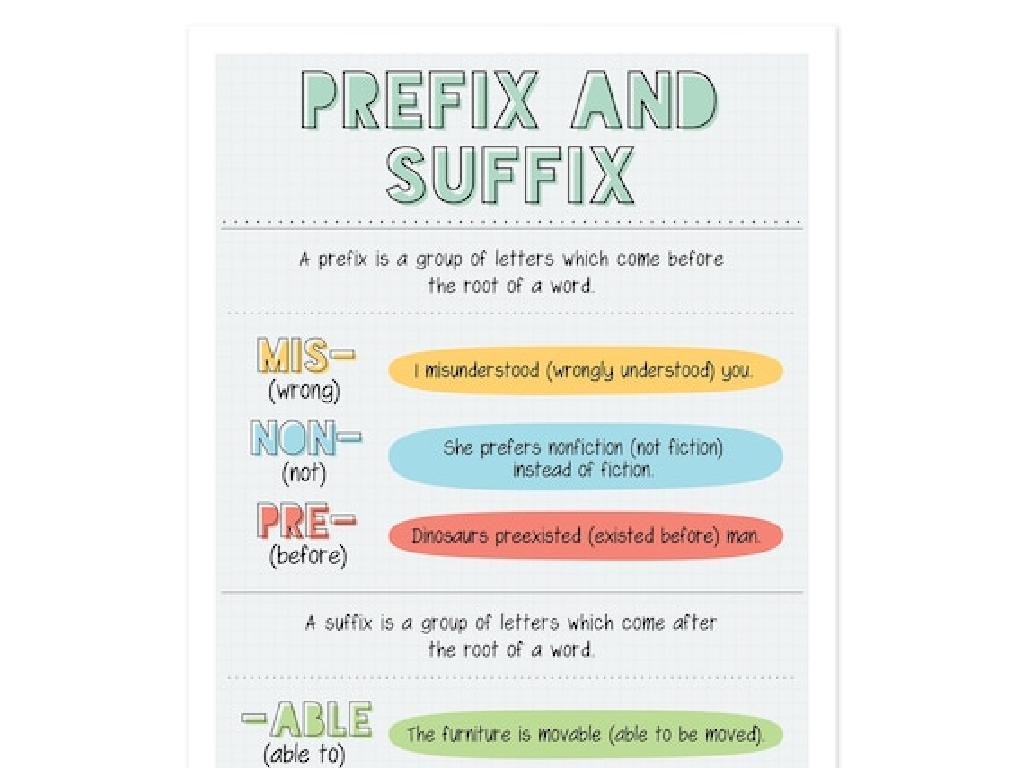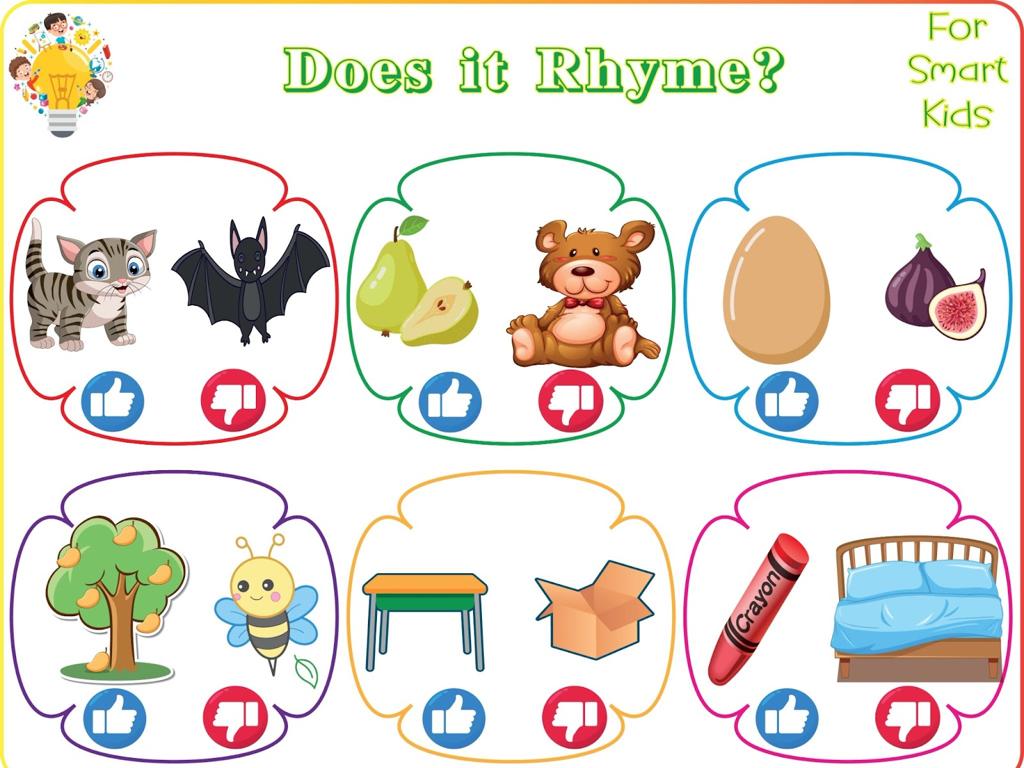Add And Subtract Fractions With Like Denominators: Word Problems
Subject: Math
Grade: Sixth grade
Topic: Add And Subtract Fractions
Please LOG IN to download the presentation. Access is available to registered users only.
View More Content
Understanding Fractions with Like Denominators
– Fractions represent parts of a whole
– Imagine a pizza cut into equal slices; each slice is a fraction of the pizza.
– Like denominators: same bottom number
– If two fractions have the same denominator, they are like fractions (e.g., 3/8 and 5/8).
– Real-life examples: pizza slices, money
– Consider sharing a pizza or spending money; these involve fractions in daily life.
– Adding/subtracting with like denominators
– To combine fractions with like denominators, add or subtract the numerators only.
|
This slide introduces students to the concept of fractions as parts of a whole and focuses on understanding like denominators. Use relatable examples such as dividing a pizza into equal parts or splitting money to illustrate fractions in real life. Emphasize that like denominators mean the denominators are the same, making it easier to add or subtract fractions. Show how to add or subtract the numerators while keeping the denominator the same. Encourage students to think of other examples where they use fractions in their daily lives. This foundational understanding will help them solve word problems involving the addition and subtraction of fractions with like denominators.
Visualizing Fractions with Pie Charts
– Pie charts represent fractions
– Each slice shows a part of the whole. How many equal slices are there?
– Identifying like denominators
– Look for slices with the same size. What do they tell us?
– Match visuals to fractions
– Find the pie chart that matches with given fractions.
– Group activity guidelines
|
This slide introduces students to the concept of visualizing fractions using pie charts, which can make understanding fractions more intuitive. Start by explaining how each pie chart represents a whole divided into equal parts. Emphasize the importance of like denominators by showing different pie charts with the same number of slices. For the group activity, provide various pie charts and a set of fraction cards. Students will work in small groups to match each fraction card with the corresponding pie chart. This activity will help reinforce their understanding of fractions with like denominators. Possible variations of the activity could include creating their own pie charts, solving word problems using the visuals, or even a pie chart scavenger hunt.
Adding Fractions with Like Denominators
– Steps to add same denominator fractions
– Ensure denominators match, then add numerators
– Example: Add 1/4 + 2/4
– 1/4 + 2/4 equals 3/4 because 1+2 equals 3
– Practice Problem: Add 3/8 + 2/8
– Combine 3/8 and 2/8 to find the sum
|
This slide introduces the concept of adding fractions with like denominators. Start by explaining that the denominator represents the total number of equal parts, and when they are the same, we can simply add the numerators. Use the example of 1/4 + 2/4 to show that the sum of the numerators (1+2) gives us 3, and since the denominator is the same (4), the answer is 3/4. For the practice problem, guide students to add 3/8 and 2/8 by adding the numerators to get 5, resulting in 5/8. Encourage students to solve the problem on their own and then discuss the solution as a class. This exercise will help solidify their understanding of adding fractions with like denominators through hands-on practice.
Subtracting Fractions with Like Denominators
– Steps to subtract fractions
– Ensure denominators are the same, then subtract numerators.
– Example: 3/4 – 1/4
– Subtract the numerators: 3 – 1 = 2, so 3/4 – 1/4 = 2/4, which simplifies to 1/2.
– Practice Problem: 5/8 – 1/8
– Follow along as we subtract: What is 5/8 – 1/8?
|
This slide is focused on teaching students the concept of subtracting fractions with like denominators. Start by explaining the steps: ensuring the denominators are the same and then subtracting the numerators. Use the example 3/4 – 1/4 to illustrate the process, showing that the answer is 2/4, which simplifies to 1/2. Then, present the practice problem 5/8 – 1/8 and solve it together with the class, reinforcing the concept. Encourage students to simplify their answers whenever possible. Provide additional practice problems for students to try on their own, ensuring they grasp the concept.
Word Problems: Adding Fractions
– Comprehend the word problem
– Read carefully to understand what is being asked.
– Find like denominators
– Ensure the fractions have the same denominator before adding.
– Solve the problem systematically
– Add the numerators, keep the denominator same, simplify if needed.
– Check your solution
– Verify your answer by re-reading the problem and checking your math.
|
This slide is aimed at helping students tackle word problems involving the addition of fractions with like denominators. Start by reading the problem thoroughly to understand what is required. Highlight the importance of identifying fractions with the same denominator, as this is crucial for adding them directly. Guide students through the steps of adding the numerators while keeping the denominator unchanged and then simplifying the resulting fraction if possible. Emphasize the importance of checking their work by revisiting the problem to ensure their solution makes sense. Provide several practice problems for students to apply these steps and reinforce their understanding.
Subtracting Fractions: Word Problems
– Read the problem carefully
– Understand what the question is asking
– Ensure denominators are the same
– Like denominators are essential for subtraction
– Subtract the numerators
– Keep the denominator, subtract only the top numbers
– Simplify the fraction if needed
– Reduce fractions to simplest form
|
This slide is aimed at teaching students how to approach word problems involving the subtraction of fractions with like denominators. Start by reading the problem thoroughly to understand what is being asked. Emphasize the importance of identifying that the denominators are the same before proceeding with subtraction. Guide students through the process of subtracting numerators while keeping the denominator constant. Finally, demonstrate how to simplify the resulting fraction, if possible. Encourage students to practice with various word problems and to check their work by ensuring the answer makes sense in the context of the problem.
Class Activity: Fraction Scavenger Hunt
– Find real-life fraction examples
– Create unique fraction word problems
– Use the fractions from your scavenger hunt to craft the problems
– Share your problems with the class
– Collaboratively solve the problems
– Work in groups to solve each other’s problems
|
This interactive class activity is designed to help students apply their knowledge of adding and subtracting fractions with like denominators to real-world scenarios. Students will first search for objects or situations around the classroom or school that can be represented as fractions. Then, they will use these examples to create their own word problems, incorporating the fractions they’ve found. Afterward, students will share their word problems with the class, and as a group, they will work through solving each problem. This activity encourages creativity, collaboration, and practical application of mathematical concepts. For the teacher: Prepare a list of potential objects or situations that could be used if students struggle to find examples. Also, have a structure in place for how students will share and solve problems to ensure that each student has the opportunity to participate.
Review and Practice: Fractions
– Review key fraction concepts
– Go over adding and subtracting fractions with the same denominator.
– Complete the practice worksheet
– Solve word problems to reinforce today’s lesson.
– Introduction to multiplying fractions
– Get a sneak peek at how to multiply fractions.
– Homework: Prepare for next class
|
This slide is aimed at reinforcing the concepts learned in today’s lesson on adding and subtracting fractions with like denominators through word problems. Begin by reviewing the key concepts, ensuring students understand the steps involved in these processes. Distribute the practice worksheet and guide students as they work through the problems, offering assistance as needed. Introduce the concept of multiplying fractions to prepare them for the next class, providing a foundation for understanding. For homework, ask students to review today’s material and look ahead to multiplying fractions, possibly by reading the relevant textbook section or watching an instructional video.





